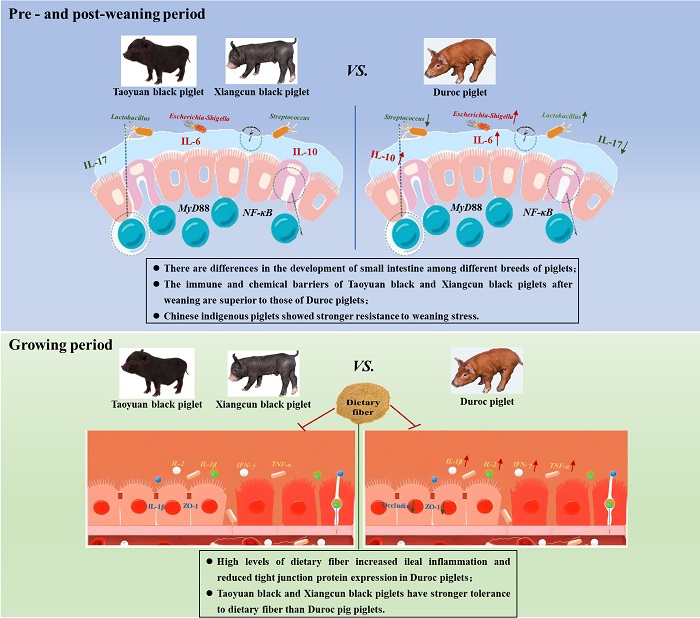Scientists Decode Weaning Resistance of Chinese Indigenous Piglets
The intestine is the main site for the digestion and absorption of nutrients, as well as the largest immune and endocrine organ in the body. Normal intestinal morphology, structure, and function can ensure the growth, development, and overall health of animals.
A research group led by Prof. Xiangfeng Kong from the Institute of Subtropical Agriculture of the Chinese Academy of Sciences systematically investigated the differences in the development of intestinal barrier and the regulatory mechanism of dietary fiber in three different breeds of pigs (Taoyuan black, Xiangcun black, and Duroc), and found that there were differences in intestinal development., Local pig breeds presented stronger resistance to weaning stress than the foreign pig breed.
Taoyuan black pig is a unique dual-purpose fat–meat pig breed in Hunan Province and a typical representative of local pig breeds in China. At present, research on Taoyuan black pigs is mainly limited to growth performance, meat quality, and resistance to roughage feeding; however, research on their intestinal barrier function and nutritional regulation is limited.
Taoyuan black, Duroc, and their cross-bred Xiangcun black (Taoyuan black pig as female parent and Duroc male pig as male parent) piglets from the same litter at 1, 10, 21, and 24 days of age were selected and investigated the developmental patterns of intestinal barrier functions and differences in response to weaning stress among different breeds of piglets.
Compared to other breeds, Chinese indigenous piglets have stronger resistance to weaning stress relative to foreign pig breeds, whereas Lactobacillus and Rothia were the major microbes which might be responsible for affecting the intestinal barrier of different breeds of pigs.
The regulatory effects of dietary fiber on the intestinal barrier function of weaned piglets of different breeds were further investigated. Compared to other two Chinese indigenous pig breeds, A higher levels of dietary fiber increased intestinal inflammation and reduced tight junction protein expression were found in Duroc piglets, indicating that Taoyuan black and Xiangcun black piglets have stronger tolerance to dietary fiber than the Duroc piglets.
“Our research findings provide a physiological and biochemical basis for explaining the stress resistance of Chinese indigenous pigs,"said Prof. Xiangfeng Kong, the corresponding author of the study,“which is of great significance for the protection and utilization of Chinese indigenous pig resources.”

Development patterns of intestinal barrier function and dietary fiber regulatory mechanism in different breeds of piglet (Image by DING Sujuan)
Contact:DING Sujuan
E-mail: jiayousujuan@hunau.edu.cn
Download attachments: